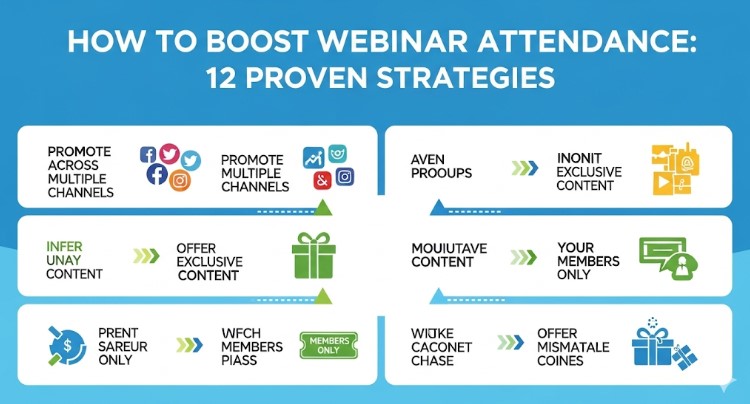Webinars have become a powerful tool for businesses looking to educate their audience, showcase their expertise, and build meaningful connections. But one common question most businesses ask is, “How many webinars should we host per month?” Finding the perfect balance can make the difference between keeping your audience engaged and overwhelming them.
This guide will explore how to determine the right webinar frequency for your business, how to balance quality with quantity, and how to promote your webinars effectively. By the end, you’ll have a better understanding of how to align your webinar strategy with your business goals.
Why Webinars Are Crucial for Business Growth
Before we get into the nitty-gritty of frequency, let’s take a moment to understand why webinars are so valuable.
Webinars allow businesses to educate and interact with their target audience in real-time. They act as a platform where companies can share insightful content, establish thought leadership, and generate high-quality leads. Unlike static content like blog posts or whitepapers, webinars foster dialogue and engagement by allowing questions, polls, and live feedback.
But just like any marketing tool, their impact depends on execution. Hosting too few webinars may mean you’re missing opportunities to connect, while hosting too many can dilute your audience’s interest.
The key lies in finding the right balance. This shift in strategy is closely tied to the rise of virtual conferences after COVID, which changed how organizations connect with audiences.
Determining the Right Frequency
How many webinars you should host depends on a mix of variables unique to your business, industry, and audience. Below are some of the key factors to consider.
Audience Size and Preferences
- How engaged is your audience?
If your audience is small but highly engaged, hosting one webinar per month could be sufficient to maintain their interest. On the other hand, larger audiences segmented by interests may benefit from a more frequent cadence to cater to their various needs.
- What does your audience expect?
Analyze your audience’s behavior. Are they eager to interact with your brand weekly, or do they prefer more infrequent but specialized content? Use polls, surveys, or past attendance metrics to gauge their preferences.
Available Resources
Webinars require a significant investment of time, effort, and often money to produce. This includes content creation, tech setup, promotions, and post-event follow-ups. If resources are tight, focus on delivering one high-impact webinar each month rather than stretching yourself too thin with multiple rushed efforts.
Content Availability
Do you have enough valuable content ideas to host frequent webinars without repetition? Each session should provide fresh insights or perspectives. If you’re struggling to brainstorm new topics that align with your brand expertise, a bi-monthly or quarterly schedule might be more sustainable.
Balancing Quality and Quantity
Value Comes First
It’s tempting to think that hosting as many webinars as possible will keep your audience engaged. However, quality always trumps quantity. Each webinar should provide real value to your attendees, whether that’s through actionable advice, original research, or expert insights.
Consider these criteria when planning content:
- Does it address a specific pain point or question your audience has?
- Are you offering insights they can’t get elsewhere?
- Can attendees walk away with something they can immediately apply or benefit from?
When you focus on delivering quality over quantity, you’ll build trust and loyalty with your audience.
Avoiding Webinar Fatigue
While webinars are valuable, overexposing your audience to too many events can lead to webinar fatigue. This happens when attendees feel overwhelmed by frequent invitations or repetitive content, causing reduced attendance and engagement.
To avoid this:
- Space your webinars evenly throughout the month.
- Use varied formats to keep things fresh (e.g., panel discussions, Q&A sessions, or case study walkthroughs).
- Reassess metrics such as attendance rates and feedback regularly to adjust your frequency strategy.
Promoting Your Webinars
A well-planned webinar won’t be impactful without attendees. Promotion is a key part of your strategy, and timing plays a crucial role.
Build a Strong Promotion Timeline
Start promoting your webinar 3-4 weeks in advance. This gives your audience ample time to register while keeping the event fresh in their minds. Send regular reminders as the event approaches, but don’t overdo it.
Maximize Your Channels
Utilize multiple channels to reach your audience:
- Email Marketing: Send targeted emails with compelling subject lines and clear calls to action.
- Social Media: Create attention-grabbing posts with visuals and hashtags to reach a wider audience.
- Landing Pages: Design a dedicated and visually engaging landing page that highlights the value of attending your webinar.
- Collaborations: Partner with influencers or other businesses to co-promote the webinar, making the event more attractive to a broader audience.
Offer Incentives to Attend
To encourage sign-ups, offer incentives like exclusive content, downloadable guides, or prizes for participation. For example, webinars with industry thought leaders often generate higher attendance due to the added value of expert opinions.
Engage Your Community
Leverage your user community by encouraging past attendees to recommend your webinars to others. Word-of-mouth referrals can significantly boost attendance while strengthening connections.
Finding the Sweet Spot for Webinar Frequency
There is no universal answer for how many webinars your business should host per month. However, keeping these principles in mind will help you strike the right balance:
- Understand your audience’s preferences and pain points.
- Prioritize quality in every webinar you create.
- Avoid overwhelming your resources or your audience by staying mindful of time commitments.
By focusing on delivering consistent value and thoughtful execution, your webinars can become a major driver of business growth and audience loyalty.
That leaves just one question: How will you make your next webinar your best one yet?








Webinar Accessibility: Best Practices for Inclusive Online Events
Enhancing Webinar Accessibility: Best Practices for Inclusive Online Events
12 Proven Webinar Engagement Tips That Actually Work
How to Boost Webinar Attendance: 12 Proven Strategies